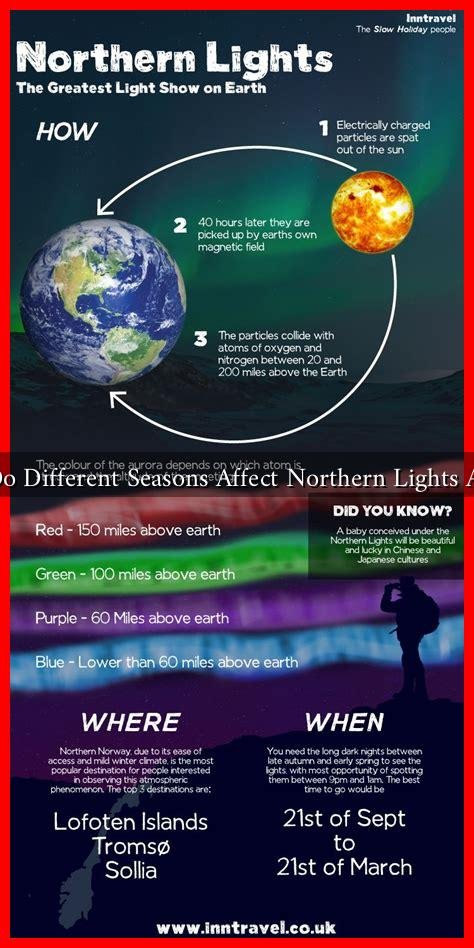-
Table of Contents
How Do Different Seasons Affect Northern Lights Activity
The Northern Lights, or Aurora Borealis, are one of nature’s most mesmerizing phenomena, captivating millions with their vibrant colors and ethereal movements. While many people associate these lights with cold, dark winter nights, the truth is that their activity is influenced by various seasonal factors. This article explores how different seasons affect Northern Lights activity, providing insights into the best times to witness this breathtaking spectacle.
The Science Behind the Northern Lights
Before delving into seasonal variations, it’s essential to understand the science behind the Northern Lights. The Aurora Borealis occurs when charged particles from the sun collide with gases in the Earth’s atmosphere. This interaction produces light, creating the stunning displays we see.
. The intensity and frequency of these displays can vary based on solar activity, which is influenced by the solar cycle—a roughly 11-year cycle of solar flares and sunspots.
Winter: The Peak Season for Northern Lights
Winter is often considered the prime season for viewing the Northern Lights, particularly in regions close to the Arctic Circle. Here’s why:
- Longer Nights: Winter nights are longer, providing more hours of darkness for optimal viewing.
- Clear Skies: Cold air often leads to clearer skies, reducing cloud cover and increasing visibility.
- Increased Solar Activity: The winter months often coincide with periods of heightened solar activity, particularly during solar maximum phases.
For example, locations like Tromsø in Norway and Fairbanks in Alaska are renowned for their winter aurora displays. According to the Geophysical Institute at the University of Alaska, Fairbanks experiences auroras on average 243 nights a year, with peak activity during the winter months.
Spring: Transition and Variability
As winter transitions to spring, Northern Lights activity can become more variable. Here’s what to expect:
- Shorter Nights: As the days lengthen, the window for viewing the auroras decreases.
- Increased Solar Activity: Spring often sees a spike in solar activity, particularly around the equinoxes, which can lead to spectacular displays.
- Weather Changes: Spring weather can be unpredictable, with more cloud cover and precipitation.
During the spring equinox, many aurora enthusiasts report increased sightings. For instance, in March 2021, a significant geomagnetic storm led to widespread aurora sightings across North America and Europe.
Summer: The Challenge of Midnight Sun
Summer presents unique challenges for aurora viewing:
- Midnight Sun: In regions above the Arctic Circle, the sun does not set for several weeks, making it nearly impossible to see the Northern Lights.
- Reduced Solar Activity: The summer months typically coincide with a decrease in solar activity.
- Increased Cloud Cover: Summer storms can lead to more cloud cover, further hindering visibility.
However, in lower latitudes, such as parts of Canada and the northern United States, auroras can still be visible during summer months, albeit less frequently. For example, in July 2022, a minor geomagnetic storm allowed for sightings in areas like Montana and North Dakota.
Autumn: A Return to Aurora Season
As summer fades into autumn, conditions become more favorable for aurora viewing:
- Longer Nights: Nights begin to lengthen, providing more opportunities for viewing.
- Increased Solar Activity: The autumn equinox often brings heightened solar activity, leading to more frequent auroras.
- Stable Weather Patterns: Autumn can offer clearer skies compared to summer storms.
In September 2021, a significant solar storm resulted in auroras visible as far south as New York City, showcasing the potential for spectacular displays during this season.
Conclusion: Timing Your Aurora Adventure
Understanding how different seasons affect Northern Lights activity is crucial for anyone hoping to witness this natural wonder. While winter remains the peak season for aurora viewing, spring and autumn also offer unique opportunities, especially during periods of increased solar activity. Summer, while challenging, can still yield sightings in lower latitudes under the right conditions.
For those planning an aurora adventure, consider visiting locations known for their aurora activity, such as Norway, Iceland, or Alaska. Keep an eye on solar forecasts and local weather conditions to maximize your chances of experiencing the breathtaking beauty of the Northern Lights.
For more information on aurora forecasts and viewing tips, visit Aurorasaurus.





